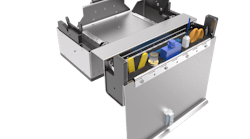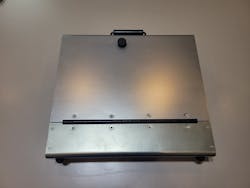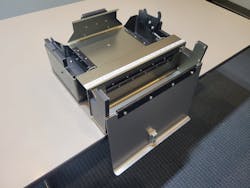Designing a Transformable Solution for Safe Traffic Cam Installation
To reduce congestion and better understand traffic patterns, many municipalities are adopting above-ground detection cameras. Mounted high above intersections, these cameras are used to give transportation departments a bird’s-eye view of vehicle and pedestrian movement while at the same time automatically feeding that information to the traffic control unit for signal light actuation, helping them improve signal light timing. As traffic information is analyzed over time, it can lead to better planning decisions.
But installing cameras 20 to 30 ft above the ground is no easy task. A technician, standing in a plastic work bucket hoisted from a truck, must use specialized tools to mount the camera and splice in fiberoptic cable that runs through the light pole to a controller on the ground. Further complicating the process, fiberoptic cable is extremely small and delicate, and handling it is especially difficult in a work bucket.
READ MORE: 5 Common Machining Mistakes to Avoid
Iterating a Toolkit
A team of engineers from Tennessee-based APTUS DesignWorks set out to improve the working conditions of these technicians by creating a briefcase that would allow for organization of tools and delicate materials while also providing a stable workbench to use high above the ground. The team collaborated with a company that installs the traffic cameras.
The goal of the project was to design a specialized, well-organized toolkit in the form of a metal briefcase. The briefcase would open to become a flat work surface where installers could safely lay their materials and ply their tools, then fold into a briefcase again for the ride down.
The team contacted Protolabs in search of a quick-turn digital manufacturer that could stay within tight tolerances while delivering on aesthetic requirements. Protolabs and its manufacturing network powered by Amsterdam-based Hubs acted as a prototyping-to-production solution that would deliver on APTUS’ goals.
READ MORE: Some Simple DFMA Magic for Sheet Metal
Briefcase-to-Workbench Design Challenges
Before a part hits the production floor, a few key design challenges would need to be solved—most importantly, the form-factor transformation from briefcase to workbench.
APTUS engineers decided to use strong but lightweight aluminum sheet metal fabrication for the bulk of the enclosure. They specified strict tolerances for gaps that arise when the toolkit is opening and closing, avoiding pinch points that could trap workers’ fingers. They also had to adhere to stringent bend radius requirements for the briefcase shell to soften its sharp edges and create a rounded, aesthetically appealing look in line with its client’s other products. And because the toolkit would be used near live voltage, the metal needed to be hard-anodized to reduce conductivity.
For parts requiring pliability—such as a pawl that engages with the teeth of a ratcheting mechanism, which APTUS designed to securely attach the opened briefcase to the lip of a work bucket—the engineers chose strong, low-cost ABS plastic manufactured through CNC machining. They also wanted to use the plastic to create a clamp for holding down the sensitive fiberoptic cable as technicians worked, and for a custom knob that was less bulky so it wouldn’t catch on any obstructions high above ground.
READ MORE: Top Tips on Designing Parts for CNC Machining
Because of the product’s exacting design details and branding specifications, APTUS knew that finding the right manufacturing partner would be key to success. APTUS chose Protolabs for this project, partly because it could accommodate the design’s special requirements, but also because its quick-turn factory solutions paired with a manufacturing network for larger-scale production allowed the company to jump right into pilot production.
The final product met all the demanding specifications, and APTUS is now producing a second batch of toolkits that will further shorten the installation process.
Jamie White is sheet metal product manager at Protolabs.


